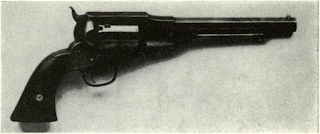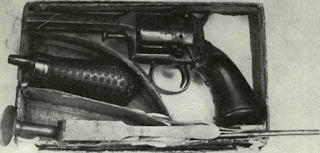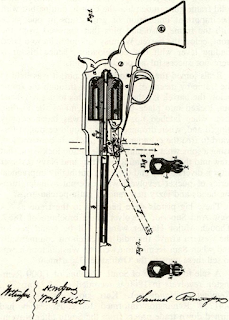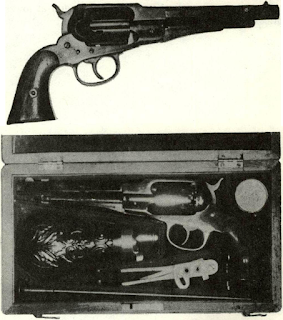When Ripley gave Eli Remington II the contract for 10.000 rifles with sword bayonets he set in motion the
50.000 or 100,000 Springfields in addition to their
Remington stated that he desired to commit his fac
With this sort of hard bargaining in cash terms star
OFFICE OF REMINGTON’S ARMORY
We are, very respectfully, your obedient servants,
E. REMINGTON & SONS
Though Eliphalet Remington III penned the letter,
The contracts given were confirmed, and the Reming
Contract
13 June
5.000 Navy revolvers cal. 36
13 June
20.000 Army revolvers cal.
11 August
6 July
$12.
Delivered
4,000 (plus 8,251)
12,505 (5,102; 14,402)
March 31, —June 22,
10,001—April 18, —
January 8,
13,908—July 8, —No
21 November
64,900 army revolvers cal.
13 December
2,500
14 December
40.000 Springfield rifle mus
24 October
15.000 Remington breech
24 October
20.000 Army revolvers cal.
62,003—November 23,
2,500
40.000—May 31, —May
15.000—September 30,
20,000— January 12, —
To final payments in May of for arms con
Of 12,251 Navy revolvers delivered and paid for,
arm was budgeted for the labor of Government in
Possibly as many as 5,100 of the first or
and on the barrel flat at that point; also on the cylinder
,
as it is usually stamped along the barrel top
Beals joined the lever to the base pin; it was held in
These big pistols were heralded to the trade as
A sale to the State of South Carolina of 1,000 Rem
The Elliott lever was more symmetrical in form, not
The pin that could be withdrawn without dropping
Details distinguishing between these three types and
Beals MI 858
Front sight: dovetail, brass or German silver cone.
Frame, solid, shrouds barrel threads completely.
Loading lever: Square at back end with web of streamline
Cylinder: Smooth, no safety notches, nipple cuts narrow as
Calibers: .36 and .44.
Barrel: Octagon, 8-inch in Army, 7‘/i-inch in Navy. Marked
Front sight: dovetail, brass or German silver cone.
Frame: Solid, transitional, may expose threads of barrel
Loading lever: Web runs forward to reenforce beneath
Cylinder: Smooth; no safety notches.
Calibers: .36 and .44.
Barrel: Octagon, 8-inch in Army, 7V4-inch in Navy. Marked:
New Model
Front sight: Iron blade cut by scooping sides of a cylindrical
Frame: Solid, does not shroud barrel threads.
Loading lever: Must be dropped to pull T-head cylinder
Cylinder: Smooth. Safety notch between each chamber for
Calibers: .36 and .44.
Barrel: Octagon, 8-inch in Army, 7‘/2-inch in Navy (some
While the detail differences noted above caused
frame. Not patentable, these simplicities greatly reduced
In its perfected form the rolling block system ap
Geiger’s breech system had a hinged block that swung
. Chambered for the .56-.50 Spencer rimfire
Remington’s War Contribution
First came the famous Zouave rifles. Though most
with foreign arms or transformed Springfields, the title
More important were the 40,000 Springfields. In
In spite of Hagner’s haggling over the values of
Now, a great corporation had emerged from the fires
During the war, production of 3,000 revolvers a
Junior,was the
sadded to
& Son.
Remington War Contracts
50.000 or 100,000 Springfields in addition to their
they are working zealously and extrahours to expedite their work.
Remington stated that he desired to commit his fac
With this sort of hard bargaining in cash terms star
OFFICE OF REMINGTON’S ARMORY
We are, very respectfully, your obedient servants,
E. REMINGTON & SONS
Though Eliphalet Remington III penned the letter,
The contracts given were confirmed, and the Reming
poundmasterof Ilion. Possibly Henry H.
Contract
13 June
5.000 Navy revolvers cal. 36
13 June
20.000 Army revolvers cal.
after a patternto be deposited.
11 August
Harpers Ferryrifles
6 July
All the army .44 revolversthey can deliver within the present year (i. e., until December 31, ) @
$12.
Delivered
4,000 (plus 8,251)
12,505 (5,102; 14,402)
March 31, —June 22,
10,001—April 18, —
January 8,
13,908—July 8, —No
21 November
64,900 army revolvers cal.
13 December
2,500
Harper’s Ferryrifles
14 December
40.000 Springfield rifle mus
24 October
15.000 Remington breech
24 October
20.000 Army revolvers cal.
62,003—November 23,
2,500
40.000—May 31, —May
15.000—September 30,
20,000— January 12, —
To final payments in May of for arms con
Of 12,251 Navy revolvers delivered and paid for,
arm was budgeted for the labor of Government in
Possibly as many as 5,100 of the first or
BealsArmy .44’s were delivered; 4,250 at $12 onModel
and on the barrel flat at that point; also on the cylinder
Four Basic Remington Handguns
Collectors confuse terminology slightly because ofNew Model; in all, six distinctly different
Beals Patent September 14,
,
as it is usually stamped along the barrel top
Beals joined the lever to the base pin; it was held in
These big pistols were heralded to the trade as
Ain a brochure of .New And Superior Revolver
all he could get forthey did not catch on commerciallythe western army
A sale to the State of South Carolina of 1,000 Rem
BealsRemington informed Judge Holt they had,44(?).
5,000 rifles for the State of MisMeanwhile, the Beals loading lever in production on the big solid frame .36 and .44 revolverssissippi, in November, . . . was also peremptorily declined.
The Elliott lever was more symmetrical in form, not
 |
| Beals type pistol is distinguished by frame covering back |
New Modelpattern.
The pin that could be withdrawn without dropping
Details distinguishing between these three types and
Beals MI 858
Front sight: dovetail, brass or German silver cone.
Frame, solid, shrouds barrel threads completely.
Loading lever: Square at back end with web of streamline
Cylinder: Smooth, no safety notches, nipple cuts narrow as
Calibers: .36 and .44.
Barrel: Octagon, 8-inch in Army, 7‘/i-inch in Navy. Marked
Front sight: dovetail, brass or German silver cone.
Frame: Solid, transitional, may expose threads of barrel
Loading lever: Web runs forward to reenforce beneath
Cylinder: Smooth; no safety notches.
Calibers: .36 and .44.
Barrel: Octagon, 8-inch in Army, 7V4-inch in Navy. Marked:
New Model
Front sight: Iron blade cut by scooping sides of a cylindrical
Frame: Solid, does not shroud barrel threads.
Loading lever: Must be dropped to pull T-head cylinder
Cylinder: Smooth. Safety notch between each chamber for
Calibers: .36 and .44.
Barrel: Octagon, 8-inch in Army, 7‘/2-inch in Navy (some
While the detail differences noted above caused
modemhandgun at a less price.
frame. Not patentable, these simplicities greatly reduced
Geiger’s Rolling Block
While Beals had his brief day at Remington, andlate flintlock period,say . Con
In its perfected form the rolling block system ap
Geiger’s breech system had a hinged block that swung
split breech Remington.It was this pattern of breech
. Chambered for the .56-.50 Spencer rimfire
Remington’s War Contribution
Remand the Springfields at $17, that Remingington rifle
First came the famous Zouave rifles. Though most
New Modelcharacteristics. First issue had fluted
with foreign arms or transformed Springfields, the title
Zouave riflehas clung to this special weapon. It is
Chasseurs de Vincennes
More important were the 40,000 Springfields. In
In spite of Hagner’s haggling over the values of
Now, a great corporation had emerged from the fires
During the war, production of 3,000 revolvers a






Comments
Post a Comment